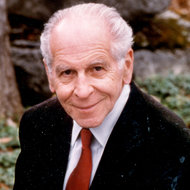Dr. Thomas Szasz, Psychiatrist Who Led Movement Against His Field, Dies at 92
By BENEDICT CAREY
Published: September 11, 2012
Thomas Szasz, a psychiatrist whose 1961 book “The Myth of Mental Illness” questioned the legitimacy of his field and provided the intellectual grounding for generations of critics, patient advocates and antipsychiatry activists, making enemies of many fellow doctors, died Saturday at his home in Manlius, N.Y. He was 92.
He died after a fall, his daughter Dr. Margot Szasz Peters said.
Dr. Szasz (pronounced sahz) published his critique at a particularly vulnerable moment for psychiatry. With Freudian theorizing just beginning to fall out of favor, the field was trying to become more medically oriented and empirically based. Fresh from Freudian training himself, Dr. Szasz saw psychiatry’s medical foundation as shaky at best, and his book hammered away, placing the discipline “in the company of alchemy and astrology.”
The book became a sensation in mental health circles, as well as a bible for those who felt misused by the mental health system.
Dr. Szasz argued against coercive treatments, like involuntary confinement, and the use of psychiatric diagnoses in the courts, calling both practices unscientific and unethical. He was soon placed in the company of other prominent critics of psychiatry, including the Canadian sociologist Erving Goffman and the French philosopher Michel Foucault.
Edward Shorter, the author of “A History of Psychiatry: From the Era of the Asylum to the Age of Prozac” (1997), called Dr. Szasz “the biggest of the antipsychiatry intellectuals.”
“Together,” he added, “they tried their hardest to keep people away from psychiatric treatment on the grounds that if patients did not have actual brain disease, their only real difficulties were ‘problems in living.’ ”
This attack had some merit in the 1950s, Dr. Shorter said, but not later on, when the field began developing more scientific approaches.
To those skeptical of modern psychiatry, however, Dr. Szasz was a foundational figure.
“We did not agree on everything, like his view that there is no such thing as mental illness,” said Vera Hassner Sharav, president and founder of the Alliance for Human Research Protection, a patient advocacy group, and a longtime critic of the field. “But his message that people get designated as ill, labeled and then shafted out of society and preyed on by an industry dominated by drugs — that’s where he was very valuable.”
After making his name, Dr. Szasz only turned up the heat. From his base in the psychiatry department of SUNY Upstate Medical University in Syracuse, he wrote hundreds of articles and more than 30 books, including “Ideology and Insanity: Essays on the Psychiatric Dehumanization of Man” (1970) and “Psychiatric Slavery: When Confinement and Coercion Masquerade as Cure” (1977).
In 1969, in a move that damaged his credibility even among allies, he joined with the Church of Scientology to found the Citizens Commission on Human Rights, which portrays the field as abusive and regularly pickets psychiatric meetings.
Dr. Szasz was not a Scientologist himself, and he later distanced himself from the church, but he shared the religion’s critical view of psychiatry. His provocations were not without cost. In the 1960s, New York mental health officials, outraged at his attacks on the state system, blocked Dr. Szasz from teaching at a state hospital where residents trained, according to two former colleagues. Dr. Szasz bristled but had little recourse, and his teaching was curtailed.
Dr. Szasz opposed the American Psychiatric Association’s broadening of its diagnoses in its new manual.
“For the record, I will say that I admired him, even though I think he was dead wrong about the nature of schizophrenia,” said Dr. E. Fuller Torrey, founder of the Treatment Advocacy Center in Arlington, Va., which supports stronger laws to ensure treatment of people with severe mental disorders. “But he made a major contribution to the issue of the misuse of psychiatry. His message is important today.”
Thomas Stephen Szasz was born in Budapest on April 15, 1920, the second child of Julius Szasz, a lawyer, and the former Lily Wellisch. The family moved to Cincinnati in 1938, where the boy became a star student. He earned a degree in physics from the University of Cincinnati and graduated from the university’s medical school in 1944.
After an internship and residency, he enrolled at the Chicago Institute for Psychoanalysis, earning his diploma in 1950. He worked at the Chicago institute and served in the United States Naval Reserve before joining the faculty of SUNY Upstate.
He wife, Rosine, died in 1971. Beside his daughter Dr. Peters, he is survived by another daughter, Suzy Szasz Palmer; a brother, George; and a grandson.
Dr. Szasz was widely sought after as a speaker and presented with dozens of national and international awards. Until the end of his life he continued to discuss psychotherapy, the practice he was trained to perform and of which he became so skeptical.
“The goal is to assume more responsibility and therefore gain more liberty and more control over one’s own life,” he said of talk therapy in an interview in 2000 with the Web site Psychotherapy.net. “The issues or questions for the patient become to what extent is he willing to recognize his evasions of responsibility, often expressed as ‘symptoms.’ ”
A version of this article appeared in print on September 12, 2012, on page A29 of the New York edition with the headline: Dr. Thomas Szasz, Psychiatrist Who Led Movement Against His Field, Dies at 92.



